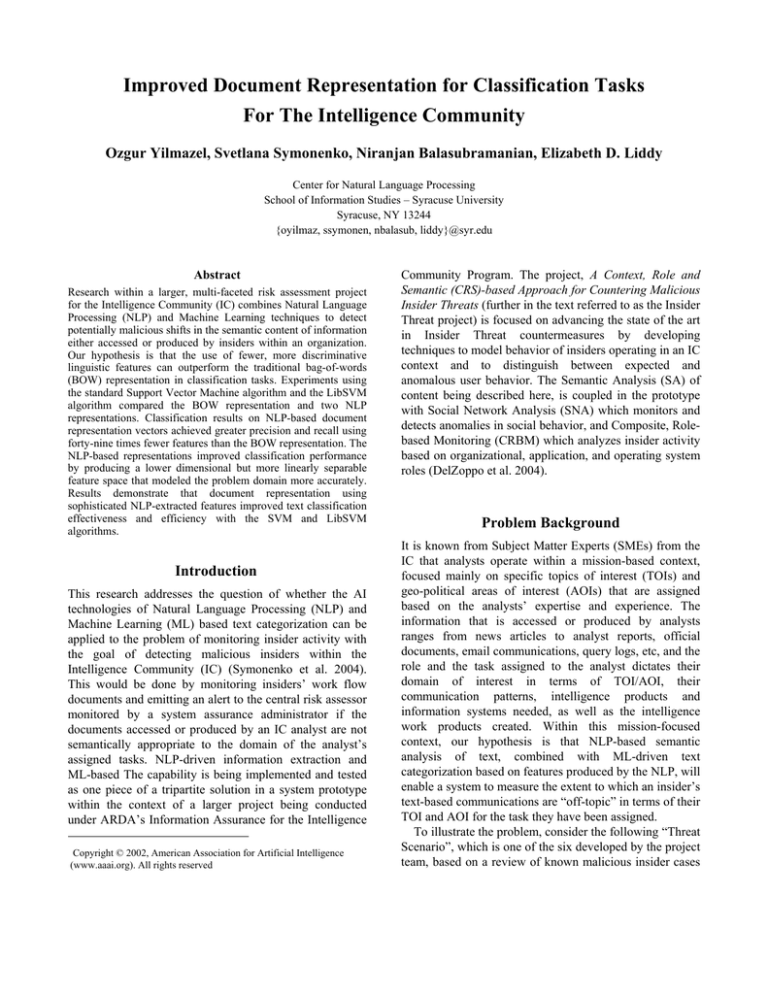
Improved Document Representation for Classification Tasks
For The Intelligence Community
Ozgur Yilmazel, Svetlana Symonenko, Niranjan Balasubramanian, Elizabeth D. Liddy
Center for Natural Language Processing
School of Information Studies – Syracuse University
Syracuse, NY 13244
{oyilmaz, ssymonen, nbalasub, liddy}@syr.edu
Abstract
Research within a larger, multi-faceted risk assessment project
for the Intelligence Community (IC) combines Natural Language
Processing (NLP) and Machine Learning techniques to detect
potentially malicious shifts in the semantic content of information
either accessed or produced by insiders within an organization.
Our hypothesis is that the use of fewer, more discriminative
linguistic features can outperform the traditional bag-of-words
(BOW) representation in classification tasks. Experiments using
the standard Support Vector Machine algorithm and the LibSVM
algorithm compared the BOW representation and two NLP
representations. Classification results on NLP-based document
representation vectors achieved greater precision and recall using
forty-nine times fewer features than the BOW representation. The
NLP-based representations improved classification performance
by producing a lower dimensional but more linearly separable
feature space that modeled the problem domain more accurately.
Results demonstrate that document representation using
sophisticated NLP-extracted features improved text classification
effectiveness and efficiency with the SVM and LibSVM
algorithms.
Introduction
This research addresses the question of whether the AI
technologies of Natural Language Processing (NLP) and
Machine Learning (ML) based text categorization can be
applied to the problem of monitoring insider activity with
the goal of detecting malicious insiders within the
Intelligence Community (IC) (Symonenko et al. 2004).
This would be done by monitoring insiders’ work flow
documents and emitting an alert to the central risk assessor
monitored by a system assurance administrator if the
documents accessed or produced by an IC analyst are not
semantically appropriate to the domain of the analyst’s
assigned tasks. NLP-driven information extraction and
ML-based The capability is being implemented and tested
as one piece of a tripartite solution in a system prototype
within the context of a larger project being conducted
under ARDA’s Information Assurance for the Intelligence
Copyright © 2002, American Association for Artificial Intelligence
(www.aaai.org). All rights reserved
Community Program. The project, A Context, Role and
Semantic (CRS)-based Approach for Countering Malicious
Insider Threats (further in the text referred to as the Insider
Threat project) is focused on advancing the state of the art
in Insider Threat countermeasures by developing
techniques to model behavior of insiders operating in an IC
context and to distinguish between expected and
anomalous user behavior. The Semantic Analysis (SA) of
content being described here, is coupled in the prototype
with Social Network Analysis (SNA) which monitors and
detects anomalies in social behavior, and Composite, Rolebased Monitoring (CRBM) which analyzes insider activity
based on organizational, application, and operating system
roles (DelZoppo et al. 2004).
Problem Background
It is known from Subject Matter Experts (SMEs) from the
IC that analysts operate within a mission-based context,
focused mainly on specific topics of interest (TOIs) and
geo-political areas of interest (AOIs) that are assigned
based on the analysts’ expertise and experience. The
information that is accessed or produced by analysts
ranges from news articles to analyst reports, official
documents, email communications, query logs, etc, and the
role and the task assigned to the analyst dictates their
domain of interest in terms of TOI/AOI, their
communication patterns, intelligence products and
information systems needed, as well as the intelligence
work products created. Within this mission-focused
context, our hypothesis is that NLP-based semantic
analysis of text, combined with ML-driven text
categorization based on features produced by the NLP, will
enable a system to measure the extent to which an insider’s
text-based communications are “off-topic” in terms of their
TOI and AOI for the task they have been assigned.
To illustrate the problem, consider the following “Threat
Scenario”, which is one of the six developed by the project
team, based on a review of known malicious insider cases
and consultations with the IC. An analyst (insider), with
appropriate security clearance, works on problems dealing
with the Biological Weapons Program (TOI) in Iraq
(AOI). For some reason, the analyst begins collecting
information on ballistic missiles in North Korea. Since the
topic is apparently beyond his assigned task, these actions
are covert, interspersed with his ‘normal’, ‘on-topic’
communications. Now and then he would query a database
and retrieve documents on North Korea’s missiles;
occasionally, he would contact a friend, another analyst
from the North Korea workshop about the country’s
missile capabilities and receive documents via email; to
pass the information to his external partners, he would
copy data to a CD or print a few documents out. As these
actions involve textual artifacts, such as documents,
database queries, emails (both messages and file
attachments), an analysis of their semantic content should
be indicative of which topics are currently of interest to the
analyst. Further comparison of these topics to what is
expected from the analyst, given the assigned task, would
reveal whether they fall within the scope of the expected
TOI/AOI.
Obviously, such actions as making phone calls or
sending documents via regular mail are beyond the scope
of the semantic analysis. To some extent, they can be
detected by other system components: the SNA monitor,
for example, will detect communication patterns, which
are unusual for the insider in terms of frequency or
communication partner. In another plausible scenario, the
insider can pose a threat by exfiltrating information to
external sources. In this case, the content of the involved
documents falls within the expected scope, so no anomaly
would be detected by the semantic analysis. However, an
unusually high volume of printing, copying or emailing to
an external source will be reported by the CRBM and SNA
monitors. Such combination of evidence of different types
and from different sources ensures the sensitivity and
robustness of the insider threat detection system which is
currently being developed.
In addition to monitoring insider’s communications,
semantic analysis can be run ex-post-facto, for example, if
an information assurance engineer’s intuition leads them to
suspect an individual. Alternatively, it can be applied to
characterize large collections of documents by generating
their conceptual models.
It is important to note that the system will not replace
human supervisors (e.g. information assurance engineers),
but rather assist them by directing their attention to the
detected ‘anomalies’. Obviously, some of these
‘anomalies’ will be ‘false alarms’, but such filtering should
still save human time otherwise spent on intuition-guided
analysis of much more data. System optimization should
then aim for the high recall of truly ‘anomalous’
indicators, while keeping the rate of ‘false alarms’ low.
Related Work
To date, the research addressing the problem of detecting
malicious insider activity has placed greater emphasis on
cyber security, with systems and networks as the main
object of such attacks. Until recently, semantics has been
mainly applied to describe the role-based access policy of
an organization (Anderson 1999; Upadhyaya, Chinchani,
and Kwiat 2001). The 2003 and 2004 Symposia on
Intelligence and Security Informatics (ISI) demonstrated
an increased appreciation of information itself as an
important factor of national security and a potential object
of attack. As information is often represented through
textual artifacts of various genres, linguistic analysis has
been actively applied to the problems related to cyber
security. Stolfo et al. (2003) mined subject lines of email
messages for patterns typical for particular user groups.
Other studies looked at linguistic indicators of deception in
interview transcripts (Burgoon et al. 2003), email
messages (Zhou, Burgoon, and Twitchell 2003), and
online chat room conversations (Twitchell, Nunamaker Jr.,
and Burgoon 2004). Bengel et al. (2004) applied
classification algorithms to the task of chat room topic
detection. Sreenath et al. (2003) employed latent semantic
analysis to reconstruct users’ original queries from their
online browsing paths and applied this technique to
detecting malicious (terrorist) trends.
Our work is conceptually related to anomaly detection
research (Anderson 1980; Lawrence and Bauer 2000). The
novelty of our approach is in its focus on the insider, who,
unlike an intruder, may possess required system security
clearance. Another important point of distinction is in that
the content of information accessed eludes the existing
intrusion detection techniques, as little can be inferred
from the available resource metadata. To address this need,
we have taken a document-driven approach that focuses on
the content. This paper reports on further developments in
the ongoing research (DelZoppo et al. 2004; Symonenko et
al. 2004) that combines NLP and ML techniques to detect
potentially threatening shifts in the content of information
accessed by an insider.
Proposed Solution
The problem of identifying documents that are off – or on
– topic can be modeled as a text categorization problem.
Categorization models of expected topics are first built
from the semantic content of a given set of documents that
reflect the analyst’s assignment. New documents are then
categorized as on-topic or off-topic based on the similarity
of their semantic content to what is expected. When the
level of risk based on off-topic documents accessed and/or
produced exceeds a pre-defined threshold, a risk indicator
is sent to the central risk assessor, which merges this
information with evidence indicators from anomaly
detectors of other cyber-observables for review and action
by an information assurance engineer.
The effectiveness of such a solution is dependent on
how well we can model expected communications and the
accuracy of the categorization models in assigning
documents that are accessed and produced to the
categories of on-topic and off-topic and as well as the
generalizability of the model to new documents. The most
commonly used document representation has been the
simple bag-of-words (BOW) (Dumais et al. 1998;
Sebastiani 2002). It has been shown that in many text
classification problems, the vocabulary of the categories
and its statistical distribution is sufficient to achieve high
performance results. However, in situations where the
available training data is limited (as is frequently true in
real-life applications), classification performance suffers.
Our hypothesis is that the use of fewer, more
discriminative linguistic features can outperform the
traditional bag-of-words representation.
Advantages of using NLP-driven representations are
two-fold. First, domain-specific feature selection, utilizing
external (domain) knowledge, reduces the feature space to
the more content-laden terms. In the IC domain, terms
indicative of AOI and TOI are more important for
describing the document content than other named entities
(for example, the name of the news agency). Therefore,
limiting document representations to AOI/TOI features
only should still provide for good conceptual separation of
documents and, thus, perform as good as, if not better than,
the BOW representation. Next, NLP-based concept
inference adds dimensions of (dis)similarity. For example,
a document reporting on a terrorist bombing in Moscow
and a document discussing a terrorist activity in Petersburg
will be considered more similar when the broader AOI
concept of ‘country’ (“Russia”) is added to both.
In brief, utilizing NLP features to produce a semantic
representation of the documents’ content makes it possible
to utilize both real world knowledge and domain
knowledge available in resources such as ontologies to
even further improve the representation that provides the
basis of the categorization.
The novelty of the proposed approach is in using
linguistic features either extracted or assigned by our NLPbased system (Liddy 2003) for document representation.
Such features include part-of-speech (POS) tags, entities
(nouns and noun phrases), named entities (proper names)
and categories of entities and named entities. Furthermore,
the system can utilize these document-based NLP features
to map into and inference about higher-level concepts in
external knowledge sources that are indicative of topics of
interest (TOI) and geo-political areas of interest (AOI).
Utilizing these more abstract features, the system can
produce document vectors that are well separated in the
feature space.
The NLP analysis is performed by TextTagger, a text
processing system built at the Center for Natural Language
Processing (CNLP). The text processing phases, fairly
standard for NLP systems, include a probabilistic part-ofspeech tagger and a sequence of shallow parsing phases
using symbolic rules in a regular expression language.
These phases employ lexico-semantic and syntactic clues
to identify and categorize entities, named entities, events,
as well as relations among them. Next, individual topics
and locations are mapped to appropriate categories in
knowledge bases by linguistic rules and an automated
querying of these knowledge bases.
The choice of knowledge bases was driven by the
context of our project – the IC with its focus on TOI and
AOI. Concept inference for TOI is supported by an
ontology developed for the Center for Nonproliferation
Studies’ (CNS) collection of documents from the
nonproliferation of weapons of mass destruction (WMD)
domain. The process of TOI inference begins when the
system recognizes that a term from a document exists in
the knowledge base. It then augments the term extraction
by all classes it belongs to. We also utilize information
about the entity, found in the “gloss”-like ontology
attributes, to enhance the term extraction with related
terms1. For the conceptual organization of AOI, we utilize
the SPAWAR Gazetteer, which combines resources of
four publicly available gazetteers: NGA (NIMA); USGS;
CIA World Factbook; and TIPSTER (Sundheim and Irie
2003). Given that analysts usually operate on the countrylevel of AOI, the concept inference for geographical terms
is set to the ‘Country’ level, but it allows for different
levels of inference granularity. The entity and event
extractions are output as frames, with relation extractions
as frame slots. Figure 1 shows sample extractions for the
named entity ‘Bavarian Liberation Army’: inferred AOI
(‘Country’) and TOI (‘CNS_Superclasses’), as well as
named entities found in the ontology “glosses”
(‘CNS_Namedentity’).
Authorities suspect the Bavarian Liberation Army, an
extreme right-wing organization, may be responsible.
Bavarian Liberation Army
Country=Austria
CNS_Namedentity=Graz
CNS_Superclasses=Terrorist-Group
Figure 1. A sample extraction and concept inference
1
this simulates analyst’s utilizing background knowledge or coming up
with useful associations
The NLP-extracted features are then used to generate
document vector representations for machine learning
algorithms.
Experimentation
Experimentation Dataset
To assess the effectiveness of using NLP-extracted
features vs. bag-of-words document representations, we
ran experiments on a subset of the collection created for
the purposes of the Insider Threat project. With the known
constraints on procuring actual data from IC operational
settings, we gathered resources that would best represent
the spectrum of textual data accessed during the analyst’s
work processes. CNS documents constitute the core of the
collection, which covers such topics as WMD and
Terrorism and is diverse in genre, encompassing, among
others, newswires, topic articles, analytic reports,
international treaties, and emails.
Training and Testing document sets were drawn from
the Insider Threat collection based on the project
scenarios. The scenarios are synthetic datasets that
represent the insiders’ workflow through atomic actions
(e.g. ‘search database’, ‘make phone call’, ‘open
document’), some of which are associated with the
documents. The scenarios include a baseline case (with no
insider threat activity) and six different threat cases. The
baseline scenario was used to develop the Training set, and
the above described threat scenario set the base for the
Testing set. The scenarios describe the workflow of
hundreds of insiders with different work roles and tasks;
for the purposes of the experiment, we focused on the
workflow of one junior analyst from the Iraq/Biological
Weapon workshop.
The documents were retrieved in a manner simulating
the analysts’ work processes: manually constructed topicspecific queries were run against the Insider Threat
collection. Figure 2 shows sample queries for the task of
collecting information on the topic of ‘Biological weapons
program in Iraq’.
+Iraq* +biologic* weapon* program
+Iraq* +biologic* manufacturing facilit* site* locat*
Figure 2. Sample queries on Iraq/Biological weapons.
For our initial experiments, we assumed that off-topic
examples can be supplied. In this particular case, ‘North
Korea/Missiles’ was chosen as malicious topic shift. ‘Offtopic’ documents were retrieved in a similar fashion by
running a set of queries on the topic of ‘missile program in
North Korea’ against the above collection. Sets of such
queries were also included in the Training and Testing
datasets. Since ‘negative’ (’off-topic’) examples were not
part of the Baseline scenario, but the classifier needed to
be trained on both ‘positive’ and ‘negative’ documents, the
latter were added to the Training set. An additional group
of documents constituted so-called “white noise”: web
pages on topics of general interest (news, technology,
sports, finance), as it is expected that, in the course of their
workday, analysts access the Web for personal reasons as
well.
Documents retrieved by ‘North Korea’ queries were
labeled as OFF-topic. All other documents were labeled as
ON-topic, since, for the purposes of the project, it will
suffice if the classifier distinguishes the off-topic
documents from the rest. For each project scenario, which
spans the period of six months, the insider accesses over
6000 documents. Half of the original Testing set was held
out for validation experiments, so the final ratio of
Training to Testing datasets was 2:1. Table 1 shows the
content and volume of the resulting Training and Testing
datasets.
Both sets come from the same domains of
Iraq/Biological weapons (ON-topic) and North
Korea/Missile (OFF-topic). While the project context
dictated an overlap between the ON-topic sets for Training
and Testing, the OFF-topic sets are disjoint, so the
classifier was tested on the unseen OFF-topic documents.
Training
Documents
Queries
Total Class
Total Set
ON-topic
(Iraq/Bio)
6382
461
6843
7008
OFF-topic
(NK/Missile)
165
165
Testing
Documents
Queries
Total Class
Total Set
ON-topic
(Iraq/Bio)
3194
222
3416
3734
OFF-topic
(NK/Missile)
183
135
318
Table 1. Training and Testing datasets
Classification experiments
We chose to run classification experiments using a Support
Vector Machine (SVM) classifier, because it has been
empirically shown that SVM outperforms kNN, Naïve
Bayes, and some other classifiers on the Reuters Collection
(Yang and Liu 1999). Joachims (2002) provides detailed
theoretical explanation of why SVMs are appropriate for
text categorization.
Categorization experiments were run in LibSVM, an
SVM-based machine learning application (Hsu, Chang,
and Lin). The basic LibSVM algorithm is a simplification
of SMO (Platt 1999) and SVMLight (Joachims 2002)
algorithms. We modified LibSVM to handle file names in
the feature vectors, and to compute a confusion matrix for
evaluation.
When producing a document representation, the goal is
to choose the features that allow document vectors
belonging to different categories to occupy compact and
disjoint regions in the feature space (Jain, Duin, and Mao
1999). We ran experiments using different types of
information that we extracted from documents for
representation in the SVM classifier:
1. Bag-of-words representation (BOW): each unique
word in the training corpus is used as a term in
the feature vector.
2. Categorized entities (CAT): only the words that
are identified as entities or named entities (proper
names) from the training corpus are used for
representation.
3. TOI/AOI extractions (TOI/AOI): only the words
that are extracted as TOI/AOI indicators are used
for representation.
4. TOI/AOI extractions + domain-important
categories (TOI/AOI_cat): feature vectors include
TOI/AOI indicators plus all entities and named
entities categorized as person, geographic or
domain-related categories.
We applied stemming, a stop-word filter, and lower case
conversion to all of the above representations. The
associated value for each term in the document
representation is the frequency of the term in that
document.
All experiments were run with the RBF kernel SVM,
default gamma, with the cost of five applied to negative
(‘off-topic’) examples (i.e. the classifier was penalized for
misclassifying ‘off-topic’ documents).
The classifier performance was assessed using standard
metrics of precision, recall, and F-score (van Rijsbergen
1979), calculated for the ON-topic class (Figure 2) where
TrueON are documents correctly classified as being ONtopic; FalseON are OFF-topic documents assigned to the
ON-topic class; TrueOFF are correctly detected OFF-topic
documents, and FalseOFF are ‘false alarms’, or ON-topic
documents mistakenly assigned to the OFF-topic class.
Precision (ON) = TrueON / (TrueON + FalseON)
Table 2 shows the results of the experiments. While the
performance of the LibSVM classifier is quite impressive
on all features sets, using more sophisticated features to
represent documents does improve the classifier’s
precision on the ON-topic class, compared to the bag-ofwords representation. Interestingly, using all extracted
entities and named entities for representation achieves
rather modest results compared to both BOW and
AOI/TOI representations. But combining AOI/TOI
extractions with entities and named entities representing
people, geographic and domain-related categories (such as
‘WMD’, ‘missile’, ‘terrorism’, etc.) shows the best results
while still using three times fewer features than the
baseline (BOW).
BOW
CAT
AOI/TOI
AOI/TOI_cat
Features
19774
10682
403
6635
Prec.
94.36
93.74
95.79
95.93
Recall
100
100
100
100
F-score
97.10
96.77
97.85
97.92
Table 2. Experimental results for the ON-topic class.
Since our project set a rather uncommon task for the
classifier, namely, to seek greater recall of ‘negative’
(OFF-topic) examples, it seems worthy to compare the
classifier performance on the OFF-topic class as well
(Table 3). This task was complicated by the small number
of OFF-topic examples (2.3% in the Training set; 8.5% in
the Testing set), which, though a realistic share in the
context of our project, poses a known problem for
generalizability of a classifier as it tends to over fit to
‘positive’ examples. The results on the OFF-topic class are
in accordance with the ones described for the ON-topic:
using AOI/TOI features alone or in combination with the
domain-important categories boosts recall of OFF-topic
documents by over 3-5% while using many fewer features.
Furthermore, the use of AOI/TOI features retains the high
precision of the OFF-topic class. This observation is in
accordance with our hypothesis that the use of NLP based
features for document representation improves the
classification performance by producing a low dimensional
but more linearly separable feature space that models the
problem domain more accurately.
BOW
CAT
AOI/TOI
AOI/TOI_cat
Precision
100
100
100
100
Recall
35.85
28.30
52.83
54.40
F-score
52.78
44.12
69.14
70.47
Recall (ON) = TrueON / (TrueON + FalseOFF)
Table 3. Experimental results for the OFF-topic class.
F-score = 2*Precision*Recall/(Precision + Recall)
Overall, the results show that the use of NLP-extracted
features and NLP-based inferencing helps to improve
performance in categorization.
Figure 2. Formulas for precision, recall, and F-score.
Classification experiments: Domain change
Since it is hard to predict what kind of malicious activity
an analyst will engage in, we would like our system to be
robust enough to identify ‘off-topic’ documents from
different subject domains without any pre-knowledge of
what these are. To explore how robust the trained classifier
is to a change in the subject domain, we ran the
experiments with the same Training set, but modified the
Testing set by drawing the OFF-topic documents from the
domain of ‘China/Nuclear weapons’ (Table 4):
Documents
Queries
Total Class
Total Set
Testing
ON-topic
OFF-topic
(Iraq/Bio)
(China/Nuclear)
13194
181
222
129
3416
310
3726
Table 4. Testing dataset with the OFF-topic documents
drawn from the ‘China/Nuclear Weapons’ domain
The results reported below (Table 5) were produced
with the same LibSVM parameters as were used in the
prior experiments: RBF kernel, default gamma, and cost of
five for misclassifying ‘off-topic’ examples. While the
performance of the classifier on the ‘ON-topic’ class
degrades somewhat, it is still satisfactory. The results
support the trend observed in the prior experiments: using
linguistic features helps improve the classifier’s
performance. In particular, combining AOI/TOI
extractions with important categories gave the best
classifier’s precision and the F-score on this dataset.
Although such an improvement may look slight, one
should bear in mind that it was achieved with almost three
times fewer features than the BOW representation.
BOW
CAT
AOI/TOI
AOI/TOI_cat
Features
19774
10682
403
6635
Prec.
91.80
91.98
91.73
92.0
Recall
100
100
100
100
F-score
95.72
95.82
95.69
95.83
Table 5. Experimental results for the ON-topic class: OFFexamples for the Testing set come from the ‘China/Nuclear
Weapons’ domain
The recall of the ’off-topic’ documents degraded for the
China/Nuclear Weapons experiment. This was an expected
consequence of the domain change for the OFF-topic
documents used for training and testing. Still, running the
classifier on the NLP-enhanced document representations
tends to outperform the baseline (BOW). It seems
appropriate to note that, since the size of the OFF-topic
class is quite small (318 documents), even the slight
change in the absolute numbers produces a noticeable
effect on the percentage results.
Summing up the results of the experiments, we conclude
that the use of NLP-enhanced features for categorization
provides the following important advantages.
1. Improvements in effectiveness – categorization
using NLP-enhanced features outperforms “bagof-words” categorization and produces a feature
space where documents are more linearly
separable.
2. Improvements in efficiency – use of NLPextracted features helps reduce the feature space
by retaining features that are more discriminating
in the problem domain.
3. Enables incorporation of external knowledge
(available in such resources as ontologies,
gazetteers) for generation of categorization
models.
Conclusion and directions for future research
Our experimental results demonstrated that document
representation using sophisticated NLP-extracted features
improved text categorization effectiveness and efficiency
with the SVM classifier. While the number of available
training documents is limited in homeland security and
intelligence environments, richer document representations
can lead to categorization models that generalize from such
limited training sets. In future research we will focus on
how different combinations of linguistic features,
extractions from text and concepts inferred from external
knowledge bases help to improve document representation
for text categorization. Another prospective research
direction will be to investigate the effectiveness of the oneclass approach, when the classifier is trained on ‘positive’
examples only, and tested on both ‘positive’ and ‘negative’
examples. This should provide us with the solution that
will better fit the context of our project, where the subject
domain of ‘off-topic’ examples is not known beforehand.
Our preliminary experiments with the one-class LibSVM
showed promising results.
Overall, the research reported herein holds potential for
providing the IC with the analytic tools to assist humans in
detecting early indicators of malicious insider activity; as
well as, when applied in the broader context, in
categorizing vast document collections.
Acknowledgements
This work was supported by the Advanced Research and
Development Activity (ARDA).
References
Center for Natural Language Processing (CNLP).
www.cnlp.org.
Center for Nonproliferation Studies (CNS).
http://cns.miis.edu/.
LibSVM. http://www.csie.ntu.edu.tw/~cjlin/libsvm/.
Anderson, J. 1980. Computer Security Threat Monitoring
and Surveillance. James P. Anderson Co.
Research and Development Initiatives Focused on
Preventing, Detecting, and Responding to Insider Misuse
of Critical Defense Information Systems: Results of a
Three-Day Workshop.
http://www.rand.org/publications/CF/CF151/CF151.pdf.
Bengel, J., Gauch, S., Mittur, E., and Vijayaraghavan, R.
2004. ChatTrack: Chat Room Topic Detection Using
Classification. In Proceedings of the Second NSF/NIJ
Symposium on Intelligence and Security Informatics
(ISI2004).
Burgoon, J., Blair, J., Qin, T., and Nunamaker, J., Jr. 2003.
Detecting Deception Through Linguistic Analysis. In
Proceedings of the First NSF/NIJ Symposium on
Intelligence and Security Informatics, Tucson, Arizona.
DelZoppo, R., Brown, E., Downey, M., Liddy, E. D.,
Symonenko, S., Park, J. S., Ho, S. M., D’Eredita, M., and
Natarajan, A. 2004. A Multi-Disciplinary Approach for
Countering Insider Threats. In Proceedings of the
Workshop on Secure Knowledge Management (SKM),
Amherst, NY.
Dumais, S., Platt, J., Heckerman, D., and Sahami, M.
1998. Inductive Learning Algorithms and Representations
for Text Categorization. In Proceedings of the Seventh
International Conference on Information and Knowledge
Management, Bethesda, Maryland, United States.
Hsu, C.-W., Chang, C.-C., and Lin, C.-J. A Practical Guide
to Support Vector Classification.
http://www.csie.ntu.edu.tw/~cjlin/papers/guide/guide.pdf.
Jain, A. K., Duin, R. P. W., and Mao, J. 1999. Statistical
Pattern Recognition: A Review. IEEE Transactions on
Pattern Analysis and Machine Intelligence 22(1): 4-37.
Joachims, T. 2002. Learning to Classify Text using
Support Vector Machines: Kluwer Academic Publishers.
Lawrence, R. H. and Bauer, R. K. 2000. AINT
misbehaving: A taxonomy of anti-intrusion techniques.
http://www.sans.org/resources/idfaq/aint.php.
Liddy, E. D. 2003. Natural Language Processing.
Encyclopedia of Library and Information Science. New
York: Marcel Decker, Inc.
Platt, J. C. 1999. Using Analytic QP and Sparseness to
Speed Training of Support Vector Machines. Advances in
Neural Information Processing Systems 11: 557-563.
Sebastiani, F. 2002. Machine Learning in Automated Text
Categorization. ACM Computing Surveys 34(1): 1-47.
citeseer.ist.psu.edu/article/sebastiani99machine.html.
Sreenath, D. V., Grosky, W. I., and Fotouhi, F. 2003.
Emergent Semantics from Users' Browsing Paths. In
Proceedings of the First NSF/NIJ Symposium on
Intelligence and Security Informatics, Tucson, AZ, USA:
Springer-Verlag.
Stolfo, S., Hershkop, S., Wang, K., Nimeskern, O., and
Hu, C. 2003. Behavior Profiling of Email. In Proceedings
of the First NSF/NIJ Symposium on Intelligence and
Security Informatics, Tucson, AZ, USA.
Sundheim, B. and Irie, R. 2003. Gazetteer Exploitation for
Question Answering: Project Summary.
Symonenko, S., Liddy, E. D., Yilmazel, O., DelZoppo, R.,
Brown, E., and Downey, M. 2004. Semantic Analysis for
Monitoring Insider Threats. In Proceedings of the Second
NSF/NIJ Symposium on Intelligence and Security
Informatics. Tucson, AZ.
Twitchell, D. P., Nunamaker Jr., J. F., and Burgoon, J. K.
2004. Using Speech Act Profiling for Deception Detection.
In Proceedings of the Second NSF/NIJ Symposium on
Intelligence and Security Informatics, Tucson, AZ.
Upadhyaya, S., Chinchani, R., and Kwiat, K. 2001. An
Analytical Framework for Reasoning About Intrusions. In
Proceedings of the 20th IEEE Symposium on Reliable
Distributed Systems.
van Rijsbergen, C. J. 1979. Information Retrieval. London:
Butterworth.
Yang, Y. and Liu, X. 1999. A Re-Examination of Text
Categorization Methods. In Proceedings of the 22nd
Annual International SIGIR, Berkeley, CA.
Zhou, L., Burgoon, J. K., and Twitchell, D. P. 2003. A
Longitudinal Analysis of Language Behavior of Deception
in E-mail. In Proceedings of the First NSF/NIJ Symposium
on Intelligence and Security Informatics, Tucson, AZ.






